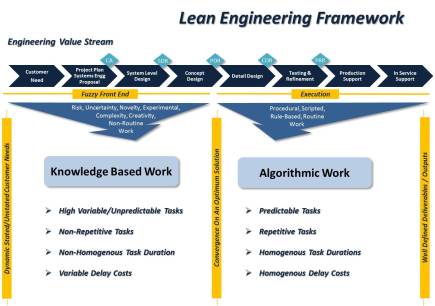Firms never have enough engineering capacity to meet their needs. Down-sizing, hiring freezes, narrow specialist expertise, labour shortages, and increasingly demographics are significant constraints on engineering capacity. Engineering work is also constrained to highly qualified staff with unique knowledge, experience, and competencies. Yet the demands on engineering are continually growing, changing, and becoming increasingly complex. Capacity shortfalls impact customer satisfaction, company reputation, and goal accomplishment potentially leading to negative fall-out and financial consequences.
If they can’t recruit, managers typically respond to capacity problems with three solutions: working overtime, prioritizing, and outsourcing. These solutions have their limitations. Lean engineering is a fourth solution that managers can use to expand their capacity by providing a systematic approach to make more efficient use of their existing talent. Engineering specialists can benefit from lean engineering because it allows them to do more of what they want to do – engineering – which in the long run fuels their career development. Significant results on the order of 5-10% improvements in efficiency can be achieved in the first year of applying lean engineering which for a 100 person engineering organization means freeing up 5-10 scarce resources to meet business needs. Committing to a lean engineering program in the long run can deliver an important competitive advantage to the business and support increased growth but it will take some effort.
Limitations of Overtime, Prioritization, & Outsourcing
What are the limitations of overtime, prioritization, and outsourcing?
Overtime enables short-term capacity surges but can hurt productivity in the medium term from the effects of fatigue and reduced morale. Unfortunately many firms have come to rely on almost continual overtime since the financial crisis. Overtime can hit overheads hard if not chargeable. If it is chargeable excessive billing can signal inefficiency directly to customers leading to cost overruns that impact the reputation of the firm. Overtime should be held in reserve to mitigate the risk of sudden surprises due to the uncertainty inherent in most engineering and new product development work.
Prioritization allows high priority committed work to be completed but delaying lower priority committed work hurts customer satisfaction that can result in lost revenue in the longer term when customers decide to go elsewhere. Depending on where high, medium, or low priority lines are drawn delaying too much work volume can have a significant impact on the business. Priority decisions should be applied where slack exists between multiple projects off the critical path on any project.
Outsourcing can be effective but can be difficult to manage. Engineering service supplier work needs to be tightly aligned with internal engineering processes, structured to meet project needs, requires extra management overhead, and can be very costly if requirements change often or are not correctly defined up-front. Outsourcing can lead to hollowing out of a firms core competencies and can create future competitors. Outsourcing can be effective in the long run but requires extensive investment in the relationship and setting up an effective work allocation/performance management system. Outsourcing engineering work is usually most effective for algorithmic tasks that can be more easily defined, packaged, and monitored with clear end deliverables.
These three solutions help solve capacity problems but are often not enough and can be overused so managers need to look at finding efficiencies. Unfortunately the process of finding efficiencies often involves an ad hoc approach with mixed, un-repeatable, or un-scalable results. Managers need a systematic approach to engineering delivery efficiency which is why managers need to take a serious look at lean engineering.
Lean Engineering
Lean engineering is about doing more with less. Lean engineering is the application of Lean Thinking to engineering and new product development work. Lean was popularized by James Womack and Daniel Jones in the early 90s with their book on Lean Thinking based on the Toyota Production System. Although lean is best know in the context of lean manufacturing, lean engineering methods have evolved as a systematic approach to gain efficiencies in engineering while taking into account the unique influences of uncertainty, complexity, variety, and creativity in engineering and new product development work. Direct application of lean manufacturing methods to engineering does not work because of these subtle differences from production work that is algorithmic, predictable, and repetitive. In fact drawing parallels with how lean is applied in manufacturing to engineering work in my experience leads to disappointment. Instead lean engineering needs to be understood by starting from the same basic principles of lean but then adopting an information based perspective.
Lean is based on the central principle of delivering only what the customer (internal and external) needs and eliminating all forms of waste. Quoting Womack & Jones lean ‘is the process of reducing effort, time, space, cost, and mistakes while producing more nearly what the customer wants’ when the customer needs it. Lean thinking is ‘a way to specify value, line up value creating actions in the best sequence, conduct activities without interruption whenever someone requests them, perform more and more efficiently’. Value creating actions are visualized as continuous work processes or value streams. While lean manufacturing focusses on the flow of physical items through a production environment, lean engineering diverges from the physical model because ‘work items‘ flowing through engineering and absorbing value derived from an engineer’s time are information based. Engineering work items are primarily virtual in the digital age thus difficult to see in the typical engineering work environment. In fact lean engineering is really about how most knowledge based professions will need to compete in the information age going forward. Software professions are already do this with Agile scrum lean methods.
Lean engineering seeks to improve how engineering value is specified, how value creating actions are lined up in the best sequence, how to conduct engineering activities without delay whenever someone requests them, and perform engineering activities more efficiently. Lean engineering involves a change in mindset. Lean engineering requires managers and staff to ‘question the status quo’ and their prevailing assumptions in how engineering work should be performed to free up capacity in the firm. In this respect lean engineering does involve the complexities of change but the results in terms of capacity efficiencies are compelling.
Waste in Engineering Burns Capacity
Waste in engineering effort is anything that does not contribute to what the customer needs or delays when the customer’s need is satisfied. Not surprisingly examples of waste in engineering include waiting for data, unnecessary tasks, multitasking, hand overs, reinventing, engineering IS tool incompatibilities, over-engineering, rework, distractions – the list is very long.
Waste in engineering can take many forms but the impact is the same – waste burns engineering capacity unnecessarily. So the underlying logic of lean engineering is that by eliminating waste the capacity of existing engineering talent can be freed up to meet the business needs including making more time for business success enablers such as talent career development and innovation to create new value for the business.
Lean Engineering Methods
There are two varieties of lean methods prevalent in engineering worth noting: lean engineering; and engineering for lean. Making this distinction is important because they represent two very different forms of value capture. The focus of lean engineering is the fast and efficient delivery of engineering work (thus freeing up engineering capacity) while the focus of engineering for lean is to enable lean manufacturing. Both are important but engineering for lean often gets more attention across the business because 80-90% of a product’s costs are ‘baked in’ during design which greatly restricts buyers and production leaders from achieving cost savings. Lean engineering should be of interest to delivery managers (ie. project managers, project engineers, functional managers, depending on organization structure of the firm) who need engineering capacity to meet their commitments.
Lean engineering methods emerged in the 1990s from global competitive pressures first in the automotive industry followed very quickly by the aerospace industry. Diffusion of automotive/aerospace lean engineering experience to other industries has been slow – awareness and lack of competitive intensity being leading reasons. Experience from the automotive and aerospace industries has demonstrated that firms can successfully implement lean engineering through value stream mapping, waste identification, process measurement, and some form of local continuous improvement methodology (usually based on DMAIC) to establish repeatable engineering processes and basic process standardization. Firms should begin standardizing algorithmic engineering processes first – such as detail drawing production, release, and the change process – then move can to processes involving more creative work when algorithmic processes demonstrate results.
The basic framework then provides the opportunity for intermediate methods such as engineering work batch sizing, capacity or WIP constraints, sequence, cadence, and synchronization. These methods allow for flow to be managed between multiple engineering processes. In the longer term more advanced lean engineering methods such as fast feedback, iteration, rapid prototyping, and simulation allow process standardization for those involving higher uncertainties where outcome is less certain – for example fuzzy front end processes supporting new products, new methods, and concept development. Agile scrum and the Lean Start-up movement are examples of more advanced lean engineering methods being applied in extreme uncertainty situations.
Key Success Factors
In my experience successful implementation of lean engineering requires time, patience, and a methodical application of a series of solutions starting from the most basic to more advanced. Strong evidence suggests that best in class performers have committed to lean engineering for longer than five years. In my experience improvements came steadily from the application of lean engineering over several years. Lean engineering is a long-term investment – lean engineering is a journey. Certainly as competitive intensity increases in an industry, like it did in automotive and aerospace, surviving firms need continuous improvement to stay in the game.
Lean engineering also requires nurturing a culture of lean within engineering and across the business. Lean requires the application of a DMAIC methodology for continuous improvement. Lean requires a performance measurement system for appropriate feedback and monitoring. Lean engineering also needs to be integrated with the firm’s business processes: project management, cost accounting, and resource allocation systems. This is achievable with the use of visual workflow methods that complement the existing systems without the need for costly investments in additional software.
Lean engineering is a solution for capacity problems that results in faster, more efficient, streamlined delivery with reduced rework. Unfortunately many firms wait until too late to begin the lean journey then don’t have enough time to respond to increased competition, increased demand, or labour shortage. Please contact me at andrew@alopex-mc.com for help deciding if lean engineering is right for your firm or to successfully implement lean engineering methods, cultural change, and ensure results are sustainable in the long run.





